Long Xia
TURA: Tool-Augmented Unified Retrieval Agent for AI Search
Aug 06, 2025Abstract:The advent of Large Language Models (LLMs) is transforming search engines into conversational AI search products, primarily using Retrieval-Augmented Generation (RAG) on web corpora. However, this paradigm has significant industrial limitations. Traditional RAG approaches struggle with real-time needs and structured queries that require accessing dynamically generated content like ticket availability or inventory. Limited to indexing static pages, search engines cannot perform the interactive queries needed for such time-sensitive data. Academic research has focused on optimizing RAG for static content, overlooking complex intents and the need for dynamic sources like databases and real-time APIs. To bridge this gap, we introduce TURA (Tool-Augmented Unified Retrieval Agent for AI Search), a novel three-stage framework that combines RAG with agentic tool-use to access both static content and dynamic, real-time information. TURA has three key components: an Intent-Aware Retrieval module to decompose queries and retrieve information sources encapsulated as Model Context Protocol (MCP) Servers, a DAG-based Task Planner that models task dependencies as a Directed Acyclic Graph (DAG) for optimal parallel execution, and a lightweight Distilled Agent Executor for efficient tool calling. TURA is the first architecture to systematically bridge the gap between static RAG and dynamic information sources for a world-class AI search product. Serving tens of millions of users, it leverages an agentic framework to deliver robust, real-time answers while meeting the low-latency demands of a large-scale industrial system.
Graph Foundation Models for Recommendation: A Comprehensive Survey
Feb 12, 2025



Abstract:Recommender systems (RS) serve as a fundamental tool for navigating the vast expanse of online information, with deep learning advancements playing an increasingly important role in improving ranking accuracy. Among these, graph neural networks (GNNs) excel at extracting higher-order structural information, while large language models (LLMs) are designed to process and comprehend natural language, making both approaches highly effective and widely adopted. Recent research has focused on graph foundation models (GFMs), which integrate the strengths of GNNs and LLMs to model complex RS problems more efficiently by leveraging the graph-based structure of user-item relationships alongside textual understanding. In this survey, we provide a comprehensive overview of GFM-based RS technologies by introducing a clear taxonomy of current approaches, diving into methodological details, and highlighting key challenges and future directions. By synthesizing recent advancements, we aim to offer valuable insights into the evolving landscape of GFM-based recommender systems.
VideoRAG: Retrieval-Augmented Generation with Extreme Long-Context Videos
Feb 03, 2025



Abstract:Retrieval-Augmented Generation (RAG) has demonstrated remarkable success in enhancing Large Language Models (LLMs) through external knowledge integration, yet its application has primarily focused on textual content, leaving the rich domain of multi-modal video knowledge predominantly unexplored. This paper introduces VideoRAG, the first retrieval-augmented generation framework specifically designed for processing and understanding extremely long-context videos. Our core innovation lies in its dual-channel architecture that seamlessly integrates (i) graph-based textual knowledge grounding for capturing cross-video semantic relationships, and (ii) multi-modal context encoding for efficiently preserving visual features. This novel design empowers VideoRAG to process unlimited-length videos by constructing precise knowledge graphs that span multiple videos while maintaining semantic dependencies through specialized multi-modal retrieval paradigms. Through comprehensive empirical evaluation on our proposed LongerVideos benchmark-comprising over 160 videos totaling 134+ hours across lecture, documentary, and entertainment categories-VideoRAG demonstrates substantial performance compared to existing RAG alternatives and long video understanding methods. The source code of VideoRAG implementation and the benchmark dataset are openly available at: https://github.com/HKUDS/VideoRAG.
OpenCity: Open Spatio-Temporal Foundation Models for Traffic Prediction
Aug 16, 2024Abstract:Accurate traffic forecasting is crucial for effective urban planning and transportation management, enabling efficient resource allocation and enhanced travel experiences. However, existing models often face limitations in generalization, struggling with zero-shot prediction on unseen regions and cities, as well as diminished long-term accuracy. This is primarily due to the inherent challenges in handling the spatial and temporal heterogeneity of traffic data, coupled with the significant distribution shift across time and space. In this work, we aim to unlock new possibilities for building versatile, resilient and adaptive spatio-temporal foundation models for traffic prediction. To achieve this goal, we introduce a novel foundation model, named OpenCity, that can effectively capture and normalize the underlying spatio-temporal patterns from diverse data characteristics, facilitating zero-shot generalization across diverse urban environments. OpenCity integrates the Transformer architecture with graph neural networks to model the complex spatio-temporal dependencies in traffic data. By pre-training OpenCity on large-scale, heterogeneous traffic datasets, we enable the model to learn rich, generalizable representations that can be seamlessly applied to a wide range of traffic forecasting scenarios. Experimental results demonstrate that OpenCity exhibits exceptional zero-shot predictive performance. Moreover, OpenCity showcases promising scaling laws, suggesting the potential for developing a truly one-for-all traffic prediction solution that can adapt to new urban contexts with minimal overhead. We made our proposed OpenCity model open-source and it is available at the following link: https://github.com/HKUDS/OpenCity.
MA4DIV: Multi-Agent Reinforcement Learning for Search Result Diversification
Mar 27, 2024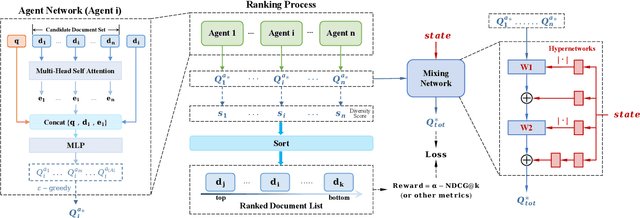

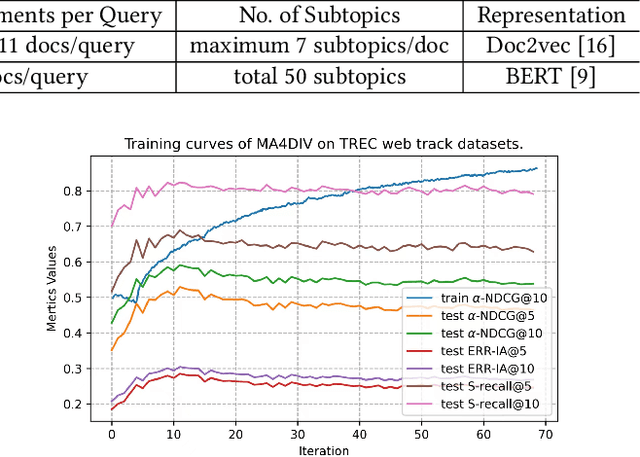

Abstract:The objective of search result diversification (SRD) is to ensure that selected documents cover as many different subtopics as possible. Existing methods primarily utilize a paradigm of "greedy selection", i.e., selecting one document with the highest diversity score at a time. These approaches tend to be inefficient and are easily trapped in a suboptimal state. In addition, some other methods aim to approximately optimize the diversity metric, such as $\alpha$-NDCG, but the results still remain suboptimal. To address these challenges, we introduce Multi-Agent reinforcement learning (MARL) for search result DIVersity, which called MA4DIV. In this approach, each document is an agent and the search result diversification is modeled as a cooperative task among multiple agents. This approach allows for directly optimizing the diversity metrics, such as $\alpha$-NDCG, while achieving high training efficiency. We conducted preliminary experiments on public TREC datasets to demonstrate the effectiveness and potential of MA4DIV. Considering the limited number of queries in public TREC datasets, we construct a large-scale dataset from industry sources and show that MA4DIV achieves substantial improvements in both effectiveness and efficiency than existing baselines on a industrial scale dataset.
HiGPT: Heterogeneous Graph Language Model
Feb 25, 2024



Abstract:Heterogeneous graph learning aims to capture complex relationships and diverse relational semantics among entities in a heterogeneous graph to obtain meaningful representations for nodes and edges. Recent advancements in heterogeneous graph neural networks (HGNNs) have achieved state-of-the-art performance by considering relation heterogeneity and using specialized message functions and aggregation rules. However, existing frameworks for heterogeneous graph learning have limitations in generalizing across diverse heterogeneous graph datasets. Most of these frameworks follow the "pre-train" and "fine-tune" paradigm on the same dataset, which restricts their capacity to adapt to new and unseen data. This raises the question: "Can we generalize heterogeneous graph models to be well-adapted to diverse downstream learning tasks with distribution shifts in both node token sets and relation type heterogeneity?'' To tackle those challenges, we propose HiGPT, a general large graph model with Heterogeneous graph instruction-tuning paradigm. Our framework enables learning from arbitrary heterogeneous graphs without the need for any fine-tuning process from downstream datasets. To handle distribution shifts in heterogeneity, we introduce an in-context heterogeneous graph tokenizer that captures semantic relationships in different heterogeneous graphs, facilitating model adaptation. We incorporate a large corpus of heterogeneity-aware graph instructions into our HiGPT, enabling the model to effectively comprehend complex relation heterogeneity and distinguish between various types of graph tokens. Furthermore, we introduce the Mixture-of-Thought (MoT) instruction augmentation paradigm to mitigate data scarcity by generating diverse and informative instructions. Through comprehensive evaluations, our proposed framework demonstrates exceptional performance in terms of generalization performance.
UrbanGPT: Spatio-Temporal Large Language Models
Feb 25, 2024



Abstract:Spatio-temporal prediction aims to forecast and gain insights into the ever-changing dynamics of urban environments across both time and space. Its purpose is to anticipate future patterns, trends, and events in diverse facets of urban life, including transportation, population movement, and crime rates. Although numerous efforts have been dedicated to developing neural network techniques for accurate predictions on spatio-temporal data, it is important to note that many of these methods heavily depend on having sufficient labeled data to generate precise spatio-temporal representations. Unfortunately, the issue of data scarcity is pervasive in practical urban sensing scenarios. Consequently, it becomes necessary to build a spatio-temporal model with strong generalization capabilities across diverse spatio-temporal learning scenarios. Taking inspiration from the remarkable achievements of large language models (LLMs), our objective is to create a spatio-temporal LLM that can exhibit exceptional generalization capabilities across a wide range of downstream urban tasks. To achieve this objective, we present the UrbanGPT, which seamlessly integrates a spatio-temporal dependency encoder with the instruction-tuning paradigm. This integration enables LLMs to comprehend the complex inter-dependencies across time and space, facilitating more comprehensive and accurate predictions under data scarcity. To validate the effectiveness of our approach, we conduct extensive experiments on various public datasets, covering different spatio-temporal prediction tasks. The results consistently demonstrate that our UrbanGPT, with its carefully designed architecture, consistently outperforms state-of-the-art baselines. These findings highlight the potential of building large language models for spatio-temporal learning, particularly in zero-shot scenarios where labeled data is scarce.
Text-Video Retrieval via Variational Multi-Modal Hypergraph Networks
Jan 06, 2024Abstract:Text-video retrieval is a challenging task that aims to identify relevant videos given textual queries. Compared to conventional textual retrieval, the main obstacle for text-video retrieval is the semantic gap between the textual nature of queries and the visual richness of video content. Previous works primarily focus on aligning the query and the video by finely aggregating word-frame matching signals. Inspired by the human cognitive process of modularly judging the relevance between text and video, the judgment needs high-order matching signal due to the consecutive and complex nature of video contents. In this paper, we propose chunk-level text-video matching, where the query chunks are extracted to describe a specific retrieval unit, and the video chunks are segmented into distinct clips from videos. We formulate the chunk-level matching as n-ary correlations modeling between words of the query and frames of the video and introduce a multi-modal hypergraph for n-ary correlation modeling. By representing textual units and video frames as nodes and using hyperedges to depict their relationships, a multi-modal hypergraph is constructed. In this way, the query and the video can be aligned in a high-order semantic space. In addition, to enhance the model's generalization ability, the extracted features are fed into a variational inference component for computation, obtaining the variational representation under the Gaussian distribution. The incorporation of hypergraphs and variational inference allows our model to capture complex, n-ary interactions among textual and visual contents. Experimental results demonstrate that our proposed method achieves state-of-the-art performance on the text-video retrieval task.
Consecutive Knowledge Meta-Adaptation Learning for Unsupervised Medical Diagnosis
Sep 21, 2022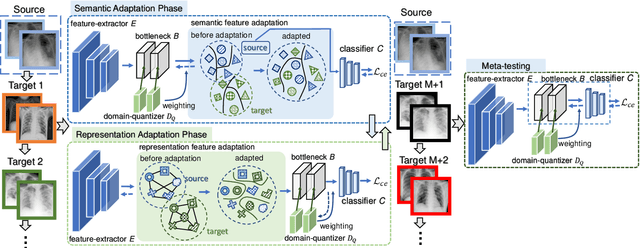
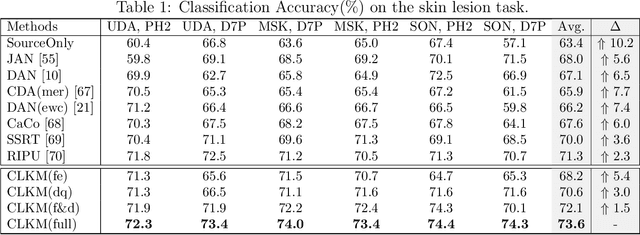
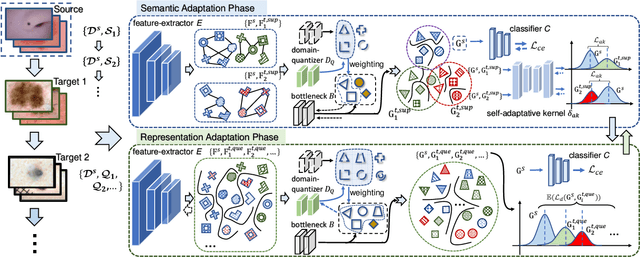
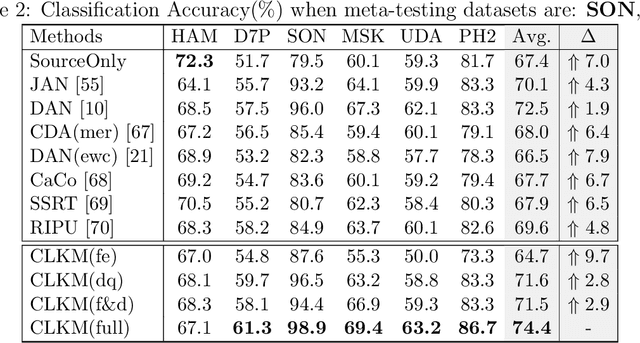
Abstract:Deep learning-based Computer-Aided Diagnosis (CAD) has attracted appealing attention in academic researches and clinical applications. Nevertheless, the Convolutional Neural Networks (CNNs) diagnosis system heavily relies on the well-labeled lesion dataset, and the sensitivity to the variation of data distribution also restricts the potential application of CNNs in CAD. Unsupervised Domain Adaptation (UDA) methods are developed to solve the expensive annotation and domain gaps problem and have achieved remarkable success in medical image analysis. Yet existing UDA approaches only adapt knowledge learned from the source lesion domain to a single target lesion domain, which is against the clinical scenario: the new unlabeled target domains to be diagnosed always arrive in an online and continual manner. Moreover, the performance of existing approaches degrades dramatically on previously learned target lesion domains, due to the newly learned knowledge overwriting the previously learned knowledge (i.e., catastrophic forgetting). To deal with the above issues, we develop a meta-adaptation framework named Consecutive Lesion Knowledge Meta-Adaptation (CLKM), which mainly consists of Semantic Adaptation Phase (SAP) and Representation Adaptation Phase (RAP) to learn the diagnosis model in an online and continual manner. In the SAP, the semantic knowledge learned from the source lesion domain is transferred to consecutive target lesion domains. In the RAP, the feature-extractor is optimized to align the transferable representation knowledge across the source and multiple target lesion domains.
Sequential Recommendation with User Evolving Preference Decomposition
Mar 31, 2022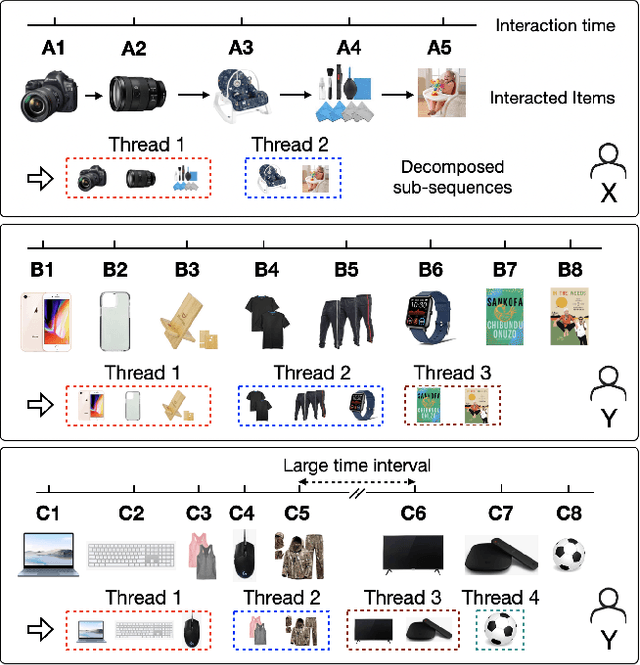
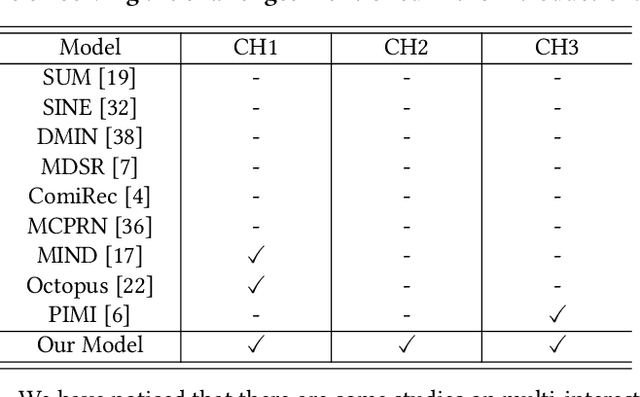
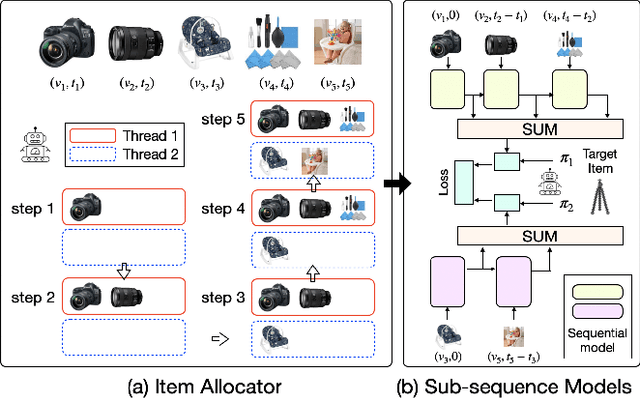
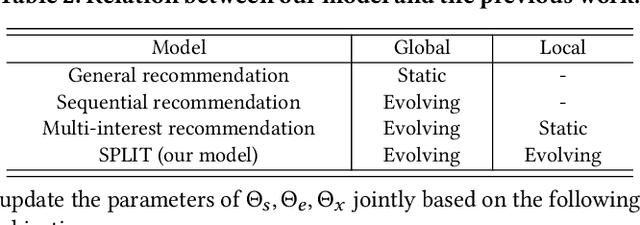
Abstract:Modeling user sequential behaviors has recently attracted increasing attention in the recommendation domain. Existing methods mostly assume coherent preference in the same sequence. However, user personalities are volatile and easily changed, and there can be multiple mixed preferences underlying user behaviors. To solve this problem, in this paper, we propose a novel sequential recommender model via decomposing and modeling user independent preferences. To achieve this goal, we highlight three practical challenges considering the inconsistent, evolving and uneven nature of the user behavior, which are seldom noticed by the previous work. For overcoming these challenges in a unified framework, we introduce a reinforcement learning module to simulate the evolution of user preference. More specifically, the action aims to allocate each item into a sub-sequence or create a new one according to how the previous items are decomposed as well as the time interval between successive behaviors. The reward is associated with the final loss of the learning objective, aiming to generate sub-sequences which can better fit the training data. We conduct extensive experiments based on six real-world datasets across different domains. Compared with the state-of-the-art methods, empirical studies manifest that our model can on average improve the performance by about 8.21%, 10.08%, 10.32%, and 9.82% on the metrics of Precision, Recall, NDCG and MRR, respectively.
 Add to Chrome
Add to Chrome Add to Firefox
Add to Firefox Add to Edge
Add to Edge